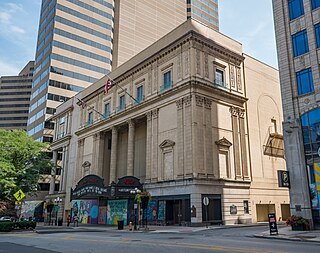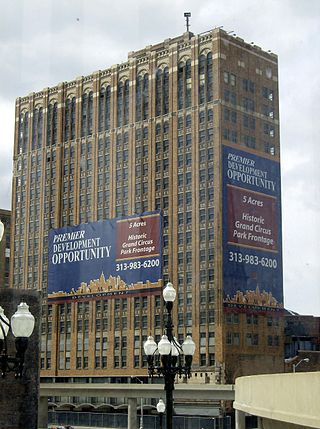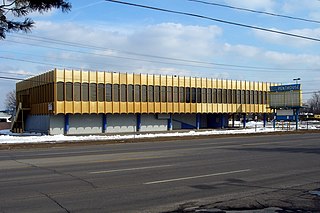
The Fox Theatre is a performing arts center located at 2211 Woodward Avenue in Downtown Detroit, Michigan, near the Grand Circus Park Historic District. Opened in 1928 as a flagship movie palace in the Fox Theatres chain, it was at over 5,000 seats the largest theater in the city. Designed by theater architect C. Howard Crane, it was listed on the National Register of Historic Places in 1985.

The Ohio Theatre is a performing arts center and former movie palace on Capitol Square in Downtown Columbus, Ohio. Known as the "Official Theatre of the State of Ohio", the 1928 building was saved from demolition in 1969 and was later completely restored. The theater was declared a National Historic Landmark in 1977.

The Fox Theatre, a former movie palace, is a performing arts center located at 527 N. Grand Blvd. in St. Louis, Missouri, United States. Also known as "The Fabulous Fox", it is situated in the arts district of the Grand Center area in Midtown St. Louis, one block north of Saint Louis University. It opened in 1929 and was completely restored in 1982.

The Lafayette Theatre(1912–1951), known locally as "the House Beautiful", was one of the most famous theaters in Harlem. It was an entertainment venue located at 132nd Street and 7th Avenue in Harlem, New York. The structure was demolished in 2013.
The Fox Theatre was a 4,651-seat movie palace located at 1350 Market Street in San Francisco, California. The theater was designed by the noted theater architect, Thomas W. Lamb. Opened in 1929, the theater operated until 1963, when it was closed and demolished.

The Woods Theatre was a movie palace at the corner of Randolph and Dearborn Streets in the Chicago Loop. It opened in 1918 and was a popular entertainment destination for decades. Originally a venue for live theater, it was later converted to show movies. It closed in 1989 and was demolished in 1990.

The United Artists Theatre Building is a vacant high-rise tower in downtown Detroit, Michigan, standing at 150 Bagley Avenue. It was built in 1928 and stands 18 stories tall. The building was designed by architect C. Howard Crane in the renaissance revival architectural style, and is made mainly of brick. Until December 29, 1971, it was a first-run movie house and office space, and then after that, the theatre saw sporadic usage until 1973. The United Artists Theatre, designed in a Spanish-Gothic design, sat 2,070 people, and after closing served from 1978 to 1983 as the Detroit Symphony Orchestra's recording theater. After the theater closed, the office block struggled as tenants moved to suburbs. It finally closed in 1984. An original 10-story, vertical UA sign was replaced in the 1950s with a marquee that remained until 2005. The building once shared a lot with the now demolished Hotel Tuller.

The Detroit Masonic Temple is the world's largest Masonic Temple. Located in the Cass Corridor neighborhood of Detroit, Michigan, at 500 Temple Street, the building serves as a home to various masonic organizations including the York Rite Sovereign College of North America. The building contains a variety of public spaces including three theaters, three ballrooms and banquet halls, and a 160 by 100 feet clear-span drill hall.

The Fillmore Detroit is a multi-use entertainment venue operated by Live Nation. Built in 1925, the Fillmore Detroit was known for most of its history as the State Theatre. It is located near the larger Fox Theatre in the Detroit Theatre District along Woodward Avenue across from Comerica Park and Grand Circus Park. The Fillmore Detroit features a theatre with a Grand Lobby and three levels of seating, as well as the State Bar & Grill which has a separate entrance and is open when the theatre is not hosting events. The Detroit Music Awards are held annually at The Fillmore Detroit in April. The building was listed on the National Register of Historic Places in 1982.
The Nederlander Organization, founded in 1912 by David T. Nederlander in Detroit, and currently based in New York City, is one of the largest operators of live theaters and music venues in the United States. Its first acquisition was a lease on the Detroit Opera House in 1912. The building was demolished in 1928. It later operated the Shubert Lafayette Theatre until its demolition in 1964 and the Riviera Theatre, both in Detroit. Since then, the organization has grown to include nine Broadway theaters, making it the second-largest owner of Broadway theaters after the Shubert Organization, and a number of theaters across the United States, including five large theaters in Chicago, plus three West End theatres in London.

Wonderland Village is an outdoor shopping center in Livonia, Michigan, United States, a suburb of Detroit. The center is located at the southwest corner of Middlebelt Road and Plymouth Road, approximately one mile south of I-96. Opened in 1959 as the outdoor Wonderland Center, it originally featured Montgomery Ward and Federal's as its major anchor stores. A 1980s renovation enclosed the formerly open-air complex and renamed it Wonderland Mall, by which point the anchor stores were Montgomery Ward, Service Merchandise, and Target. This configuration lasted throughout the late 1990s, by which point the closure of both Service Merchandise and Montgomery Ward had led to a number of vacancies. The center reopened officially in 2007.

The Quo Vadis Entertainment Center was a movie theater in Westland, Michigan. Opened in 1966, it closed in 2002 and then remained vacant until it was demolished in 2011. It was noted for its modernist exterior designed by architect Minoru Yamasaki, as well as for being one of the first cinemas to offer cocktail drinks.

The Ogden Theatre is a music venue and former movie theater in Denver, Colorado, United States. Located at 935 E. Colfax Avenue in the neighborhood of Capitol Hill, it was built in 1917 and has a maximum capacity of 1,600 for concerts. It is listed on the National Register of Historic Places.

The Park Avenue Building is a 12-story beaux-arts high-rise located at 2001–2017 Park Avenue in the Grand Circus Park Historic District in Downtown Detroit, Michigan. Formerly known as the General Necessities Building, the 101,565 sq. ft. office building was designed by Albert Kahn in 1922.

The Monroe Avenue Commercial Buildings, also known as the Monroe Block, is a historic district located along a block-and-a-half stretch at 16-118 Monroe Avenue in Detroit, Michigan, just off Woodward Avenue at the northern end of Campus Martius. The district was designated a Michigan State Historic Site in 1974 and listed on the National Register of Historic Places in 1975. The thirteen original buildings were built between 1852 and 1911 and ranged from two to five stories in height. The National Theatre, built in 1911, was the oldest surviving theatre in Detroit, a part of the city's original theatre district of the late 19th century, and the sole surviving structure from the original Monroe Avenue Commercial Buildings historic period.

Ford Auditorium was a 2,920-seat auditorium in Detroit, Michigan built in 1955 and opened in 1956. Located on the Detroit riverfront, it served as a home to the Detroit Symphony Orchestra (DSO) for more than 33 years and was an integral part of the city's Civic Center. With approval from the Ford family and the city, the building was demolished in July 2011 as part of the city's waterfront redesign plans.

State Palace Theatre is a performing arts venue located in downtown New Orleans, Louisiana. It is located at the uptown lake corner of Canal Street and Rampart Street. The Saenger Theater is directly opposite the State Palace on Canal Street.
The performing arts in Detroit include orchestra, live music, and theater, with more than a dozen performing arts venues. The stages and old time film palaces are generally located along Woodward Avenue, the city's central thoroughfare, in the Downtown, Midtown, and New Center areas. Some additional venues are located in neighborhood areas of the city. Many of the city's significant historic theaters have been revitalized.
The Utah Theatre was a historic theater in Salt Lake City, Utah in the United States. It opened in 1918 as the Pantages Theater, after the name of its owner, Alexander Pantages. The theatre was located at 148 South Main Street, Salt Lake City.
The Psychedelic Supermarket was an underground music venue in Boston, Massachusetts, that was open in the 1960s, and became one of the core establishments of the city's psychedelic rock scene. It stood at 590 Commonwealth Avenue inside a parking garage that was converted into a club by promoter George Papadopoulos in 1967. The Psychedelic Supermarket was active for two years, before its closing.















